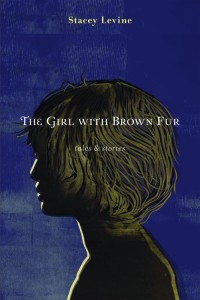Stacey Levine on Ryan Boudinot: “This one whom some were following was calm and restrained. His work shows so much work. Thousands of bees in his brain. His work makes its own ceiling, then bursts the ceiling again and again. Those calm, compact manners and the close shave. But you sense at any moment the gentlemanly restraint could fall away. At the spelling bee he was the most polite of them all. He is not in love with the normal. But I think he dislikes the abnormal, because, after all, the normal and its trajectory is so much more complicated and interesting.”
The Girl with Brown Fur by Stacey Levine
 Couched within the strange fables in Stacey Levine’s latest story collection The Girl with Brown Fur are recognizable hurts and self-defeating desires. The way she writes about such things is what makes her fiction the elegant, precise and transcendent wonderland it is. For instance, in the story “The Girl,” the narrator sees a young girl on a leash in the hallway of a hotel, and determines to steal her. As we enter the mind of a child-abductor, we register the obsessive thinking, the cagey strategizing – it’s distasteful, ominous. Then a chance remarks reveals the narrator is a woman, one who has always nursed “the wish to transform into someone else, a different kind of body, to find another story in which to live.” Clearly she is appropriating the girl as way to do this, and the urge is as uneasily recognizable as it is licentious. The story plays with power dynamics in a new way – the animalistic qualities the narrator projects onto the girl (the one with brown fur) make a subtle point about exploitation but also tilt the story into poetry.
Couched within the strange fables in Stacey Levine’s latest story collection The Girl with Brown Fur are recognizable hurts and self-defeating desires. The way she writes about such things is what makes her fiction the elegant, precise and transcendent wonderland it is. For instance, in the story “The Girl,” the narrator sees a young girl on a leash in the hallway of a hotel, and determines to steal her. As we enter the mind of a child-abductor, we register the obsessive thinking, the cagey strategizing – it’s distasteful, ominous. Then a chance remarks reveals the narrator is a woman, one who has always nursed “the wish to transform into someone else, a different kind of body, to find another story in which to live.” Clearly she is appropriating the girl as way to do this, and the urge is as uneasily recognizable as it is licentious. The story plays with power dynamics in a new way – the animalistic qualities the narrator projects onto the girl (the one with brown fur) make a subtle point about exploitation but also tilt the story into poetry.
This is Levine’s genius – to make her points allusively, in an allegorical code, one that nevertheless always feels down-to-earth and revealing of very real pockets in the human psyche. In an interview included with the press package of her new collection, she says: “It wouldn’t mean anything to say outright: ‘He was feeling really anxious because he had always been criticized by his father.’ But it does mean something for me to tell how that would feel, to try to share that experience in a new way.” The technique she has developed for doing this leads her into sometimes surreal and hilarious allegories – about mass production work in a sausage factory (“Sausage”), for example, or a brother and sister who marry each other, with their parents’ approval, and incite wrath only when they want to move out of the family house.
May 12th, 2011 / 5:49 pm
Interview w/ Lily Hoang & Stacey Levine
 Lisp Service has just posted an interview with Lily Hoang and Stacey Levine, in which they discuss the writing process, creation of fable worlds, Oulipo, speculative fiction, and various other interesting topics in the form of craft of strange lit.
Lisp Service has just posted an interview with Lily Hoang and Stacey Levine, in which they discuss the writing process, creation of fable worlds, Oulipo, speculative fiction, and various other interesting topics in the form of craft of strange lit.
Levine on small presses:
My work was rejected by the big guns New York publishers. I’m with a semi-larger house for my next book, but it’s still an independent (MacAdam/Cage). Still, I’ve been happy with smaller presses. They suit me and my slow way of writing. Of course, they have their well-known downsides…. Yet with smaller houses, there’s less nonsense like the imperative to sell, sell no matter what, the crazy competitiveness and drive to promote that is discombobulating and not very real, in a way. I mean, we’re all going to die anyway, whether we have loudly and lavishly-published books or not. The most important is to have people around the book who love it.
I like the idea of pairing two writers of a similar ilk and having them interweave in the discussion… read the rest!
